Report on Toyota: Exploring Management and Operations Strategies
VerifiedAdded on 2020/11/12
|19
|5848
|434
Report
AI Summary
This report provides a detailed analysis of Toyota's management and operations. It begins with an introduction to the organization, its management structure, and the roles of managers and leaders, highlighting their differences and how they function in various organizational situations. The report then delves into management theories, including classical, behavioral, and systems theories, evaluating their strengths and weaknesses in the context of Toyota. Task 2 focuses on Toyota's key operations, including operational functions, roles and responsibilities, and operational approaches. It evaluates the impact of external business environment factors on Toyota and explores approaches to leadership and management aimed at improving operational efficiencies. The report concludes with recommendations for future improvements, offering a comprehensive overview of Toyota's management and operational strategies.
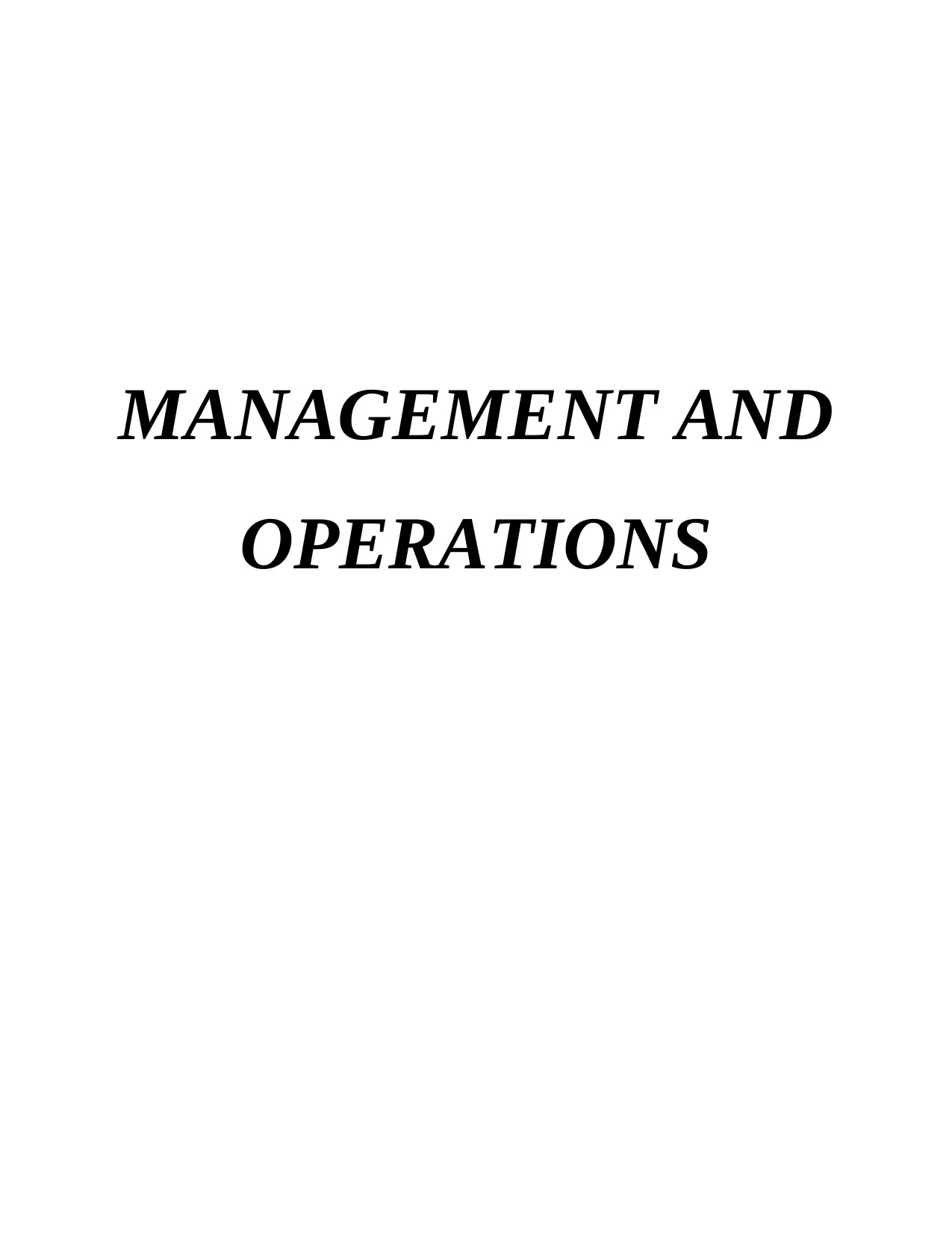
MANAGEMENT AND
OPERATIONS
OPERATIONS
Paraphrase This Document
Need a fresh take? Get an instant paraphrase of this document with our AI Paraphraser

Table of Contents
INTRODUCTION...........................................................................................................................1
TASK 1............................................................................................................................................1
1 Introduction of the organisation and its management structure..........................................1
2.Definition and roles of both managers and leaders and their differences...........................3
3. Different roles of managers and leaders in different organisational situations..................5
Management theories..............................................................................................................6
4. Theories of leadership........................................................................................................7
5.Conclusions on how managers and leaders have made an impact on the organisation......9
Task 2...............................................................................................................................................9
1 Introduction to Key Operations of Toyota..........................................................................9
2. key operational function and roles and responsibilities of managers.................................9
3. key operational approaches of operational management..................................................11
4. Evaluation of Impact of External Business Environment Factors on Toyota..................12
5. Approaches to Leadership and Management to Improve Operational Efficiencies.........14
6. Conclusion and Recommendation for future improvements............................................15
CONCLUSION..............................................................................................................................16
REFRENCES.................................................................................................................................17
INTRODUCTION...........................................................................................................................1
TASK 1............................................................................................................................................1
1 Introduction of the organisation and its management structure..........................................1
2.Definition and roles of both managers and leaders and their differences...........................3
3. Different roles of managers and leaders in different organisational situations..................5
Management theories..............................................................................................................6
4. Theories of leadership........................................................................................................7
5.Conclusions on how managers and leaders have made an impact on the organisation......9
Task 2...............................................................................................................................................9
1 Introduction to Key Operations of Toyota..........................................................................9
2. key operational function and roles and responsibilities of managers.................................9
3. key operational approaches of operational management..................................................11
4. Evaluation of Impact of External Business Environment Factors on Toyota..................12
5. Approaches to Leadership and Management to Improve Operational Efficiencies.........14
6. Conclusion and Recommendation for future improvements............................................15
CONCLUSION..............................................................................................................................16
REFRENCES.................................................................................................................................17
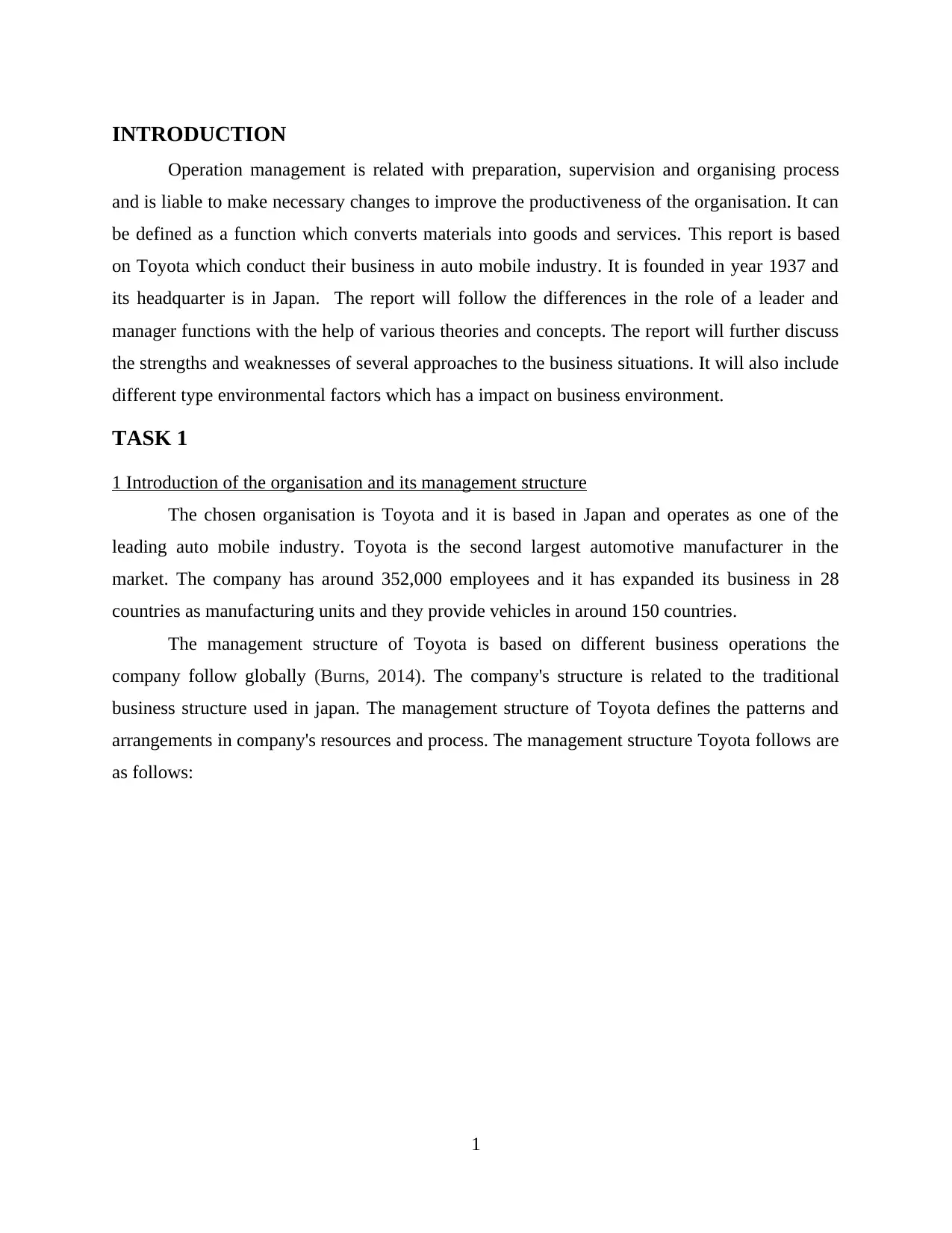
INTRODUCTION
Operation management is related with preparation, supervision and organising process
and is liable to make necessary changes to improve the productiveness of the organisation. It can
be defined as a function which converts materials into goods and services. This report is based
on Toyota which conduct their business in auto mobile industry. It is founded in year 1937 and
its headquarter is in Japan. The report will follow the differences in the role of a leader and
manager functions with the help of various theories and concepts. The report will further discuss
the strengths and weaknesses of several approaches to the business situations. It will also include
different type environmental factors which has a impact on business environment.
TASK 1
1 Introduction of the organisation and its management structure
The chosen organisation is Toyota and it is based in Japan and operates as one of the
leading auto mobile industry. Toyota is the second largest automotive manufacturer in the
market. The company has around 352,000 employees and it has expanded its business in 28
countries as manufacturing units and they provide vehicles in around 150 countries.
The management structure of Toyota is based on different business operations the
company follow globally (Burns, 2014). The company's structure is related to the traditional
business structure used in japan. The management structure of Toyota defines the patterns and
arrangements in company's resources and process. The management structure Toyota follows are
as follows:
1
Operation management is related with preparation, supervision and organising process
and is liable to make necessary changes to improve the productiveness of the organisation. It can
be defined as a function which converts materials into goods and services. This report is based
on Toyota which conduct their business in auto mobile industry. It is founded in year 1937 and
its headquarter is in Japan. The report will follow the differences in the role of a leader and
manager functions with the help of various theories and concepts. The report will further discuss
the strengths and weaknesses of several approaches to the business situations. It will also include
different type environmental factors which has a impact on business environment.
TASK 1
1 Introduction of the organisation and its management structure
The chosen organisation is Toyota and it is based in Japan and operates as one of the
leading auto mobile industry. Toyota is the second largest automotive manufacturer in the
market. The company has around 352,000 employees and it has expanded its business in 28
countries as manufacturing units and they provide vehicles in around 150 countries.
The management structure of Toyota is based on different business operations the
company follow globally (Burns, 2014). The company's structure is related to the traditional
business structure used in japan. The management structure of Toyota defines the patterns and
arrangements in company's resources and process. The management structure Toyota follows are
as follows:
1
⊘ This is a preview!⊘
Do you want full access?
Subscribe today to unlock all pages.

Trusted by 1+ million students worldwide
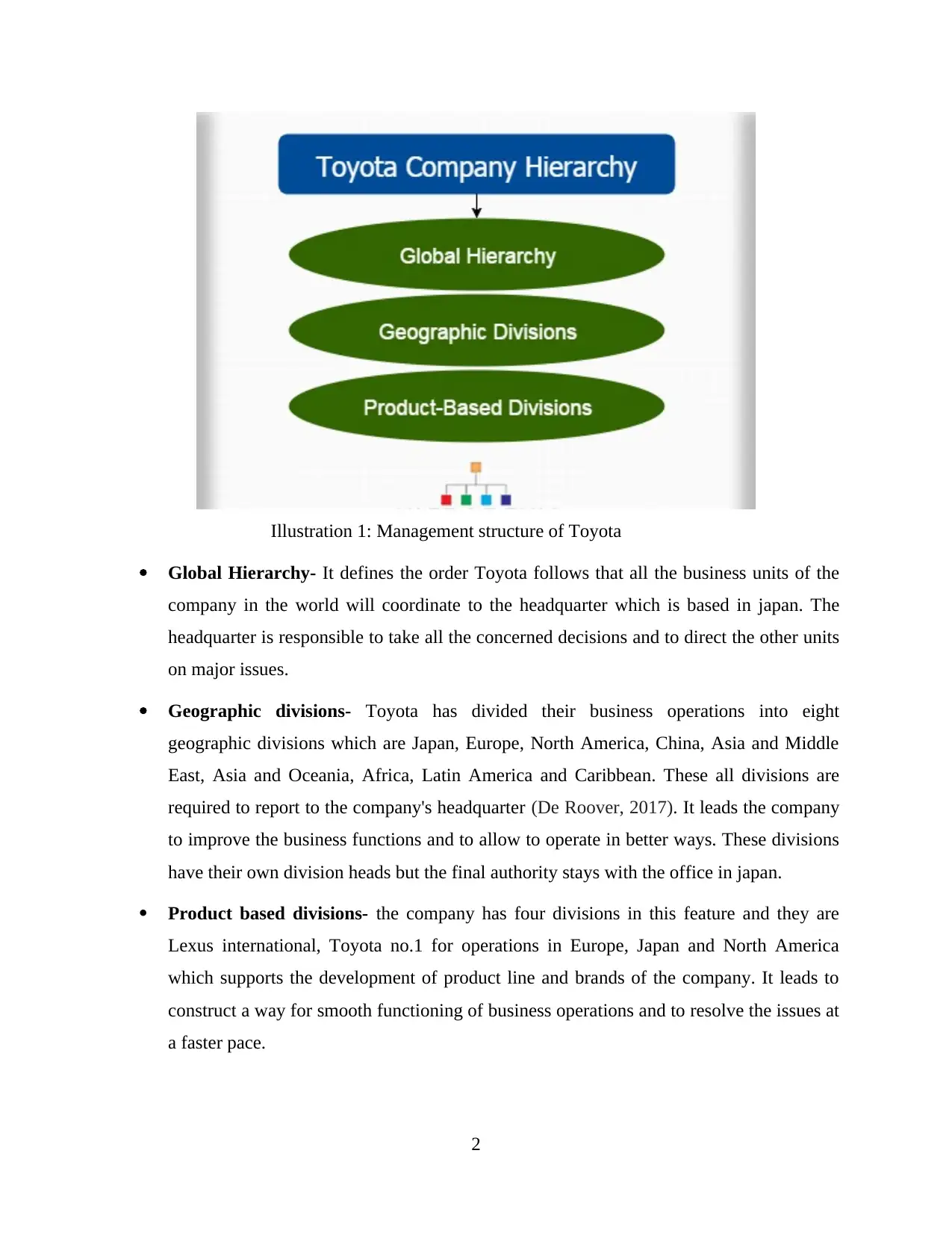
Illustration 1: Management structure of Toyota
Global Hierarchy- It defines the order Toyota follows that all the business units of the
company in the world will coordinate to the headquarter which is based in japan. The
headquarter is responsible to take all the concerned decisions and to direct the other units
on major issues.
Geographic divisions- Toyota has divided their business operations into eight
geographic divisions which are Japan, Europe, North America, China, Asia and Middle
East, Asia and Oceania, Africa, Latin America and Caribbean. These all divisions are
required to report to the company's headquarter (De Roover, 2017). It leads the company
to improve the business functions and to allow to operate in better ways. These divisions
have their own division heads but the final authority stays with the office in japan.
Product based divisions- the company has four divisions in this feature and they are
Lexus international, Toyota no.1 for operations in Europe, Japan and North America
which supports the development of product line and brands of the company. It leads to
construct a way for smooth functioning of business operations and to resolve the issues at
a faster pace.
2
Global Hierarchy- It defines the order Toyota follows that all the business units of the
company in the world will coordinate to the headquarter which is based in japan. The
headquarter is responsible to take all the concerned decisions and to direct the other units
on major issues.
Geographic divisions- Toyota has divided their business operations into eight
geographic divisions which are Japan, Europe, North America, China, Asia and Middle
East, Asia and Oceania, Africa, Latin America and Caribbean. These all divisions are
required to report to the company's headquarter (De Roover, 2017). It leads the company
to improve the business functions and to allow to operate in better ways. These divisions
have their own division heads but the final authority stays with the office in japan.
Product based divisions- the company has four divisions in this feature and they are
Lexus international, Toyota no.1 for operations in Europe, Japan and North America
which supports the development of product line and brands of the company. It leads to
construct a way for smooth functioning of business operations and to resolve the issues at
a faster pace.
2
Paraphrase This Document
Need a fresh take? Get an instant paraphrase of this document with our AI Paraphraser

2.Definition and roles of both managers and leaders and their differences
Managers can be characterised as a person who is accountable for controlling and
managing the department and its employees in the organisation. The primary duty of manager is
to assure cooperation to the employees with health and safety legislation (Harrison and Lock,
2017).
Leader can be defined as a person who has the superior ability in there field, who
influences other workers to perform task in a proper manner to attain the organisational goals.
Difference between Management and Leadership
Basis Management Leadership
Influence Management can influence the
authorised powers of managers
in the company.
It influences the skills and abilities
of the leaders by which they can
influence other people to work for
the objectives.
Focus Management focuses on the
procedures of the organisation.
Leadership focuses on skills of
individual to achieve the desired
targets.
Approaches It is essential for management to
follow different approaches to
accomplish the goals in an
effective manner. The
approaches can be like scientific,
behavioural, etc.
Leadership follow different
leadership styles such as autocratic,
democratic, transformational, etc.
Characteristics of a leader and a manager.
Manager
Manager is required to have complete focus on the desired outcome and for that it is essential to
manage the employees to perform their duties in effective manner. Manager is also required to
measure the performance level of the working staff so that weaknesses and strengths can be
3
Managers can be characterised as a person who is accountable for controlling and
managing the department and its employees in the organisation. The primary duty of manager is
to assure cooperation to the employees with health and safety legislation (Harrison and Lock,
2017).
Leader can be defined as a person who has the superior ability in there field, who
influences other workers to perform task in a proper manner to attain the organisational goals.
Difference between Management and Leadership
Basis Management Leadership
Influence Management can influence the
authorised powers of managers
in the company.
It influences the skills and abilities
of the leaders by which they can
influence other people to work for
the objectives.
Focus Management focuses on the
procedures of the organisation.
Leadership focuses on skills of
individual to achieve the desired
targets.
Approaches It is essential for management to
follow different approaches to
accomplish the goals in an
effective manner. The
approaches can be like scientific,
behavioural, etc.
Leadership follow different
leadership styles such as autocratic,
democratic, transformational, etc.
Characteristics of a leader and a manager.
Manager
Manager is required to have complete focus on the desired outcome and for that it is essential to
manage the employees to perform their duties in effective manner. Manager is also required to
measure the performance level of the working staff so that weaknesses and strengths can be
3

analysed properly and the required steps can be taken to overcome any difficulties faced by the
organisation with the skills and abilities possessed by a manger.
Characteristics of Leader
A leader consists of good communication skills that help in defining the clear set of
duties to the staff members on the basis of their skills and abilities in effective manner. Leader
provides proper guidance and training to the employees to make them perform in efficient way.
.
Functions of managers
Managers are required to set a clear objective for each department in the organisation that
will lead in defining properly the role and duties of each individual in the firm and will help in
accomplishing the desired target within a set period of time. Managers of Toyota has to
formulate effective managerial strategies to attain the set targets in effective and efficient
manner. They have the responsibility to conduct proper training and developments programs for
the employees to motivate them and to increase their working ability. The managers of Toyota
performs their duties with full of their potential to increase the brand image in the market and to
acquire the market share in great level.
Functions of leaders
The functions of leaders consist of handling the issues related to the workplace and to
handle and resolve them effectively and to create a good working environment for the employees
to perform their duties in a productive manner. A leader is required to construct a proper
communication channel between the management and the workers to maintain good relations
within the organisation and to deliver the important information or instructions of the
management to workers and the requirement and needs of the workers to the employees.
Roles of managers
Informational Role- Manager is required to provide the accurate information to the
members of the organisation. The information can be external as well as internal. The
internal information will be related to employees, products and services of Toyota,
whereas, external information will be about market demands, competitors, etc.
4
organisation with the skills and abilities possessed by a manger.
Characteristics of Leader
A leader consists of good communication skills that help in defining the clear set of
duties to the staff members on the basis of their skills and abilities in effective manner. Leader
provides proper guidance and training to the employees to make them perform in efficient way.
.
Functions of managers
Managers are required to set a clear objective for each department in the organisation that
will lead in defining properly the role and duties of each individual in the firm and will help in
accomplishing the desired target within a set period of time. Managers of Toyota has to
formulate effective managerial strategies to attain the set targets in effective and efficient
manner. They have the responsibility to conduct proper training and developments programs for
the employees to motivate them and to increase their working ability. The managers of Toyota
performs their duties with full of their potential to increase the brand image in the market and to
acquire the market share in great level.
Functions of leaders
The functions of leaders consist of handling the issues related to the workplace and to
handle and resolve them effectively and to create a good working environment for the employees
to perform their duties in a productive manner. A leader is required to construct a proper
communication channel between the management and the workers to maintain good relations
within the organisation and to deliver the important information or instructions of the
management to workers and the requirement and needs of the workers to the employees.
Roles of managers
Informational Role- Manager is required to provide the accurate information to the
members of the organisation. The information can be external as well as internal. The
internal information will be related to employees, products and services of Toyota,
whereas, external information will be about market demands, competitors, etc.
4
⊘ This is a preview!⊘
Do you want full access?
Subscribe today to unlock all pages.

Trusted by 1+ million students worldwide
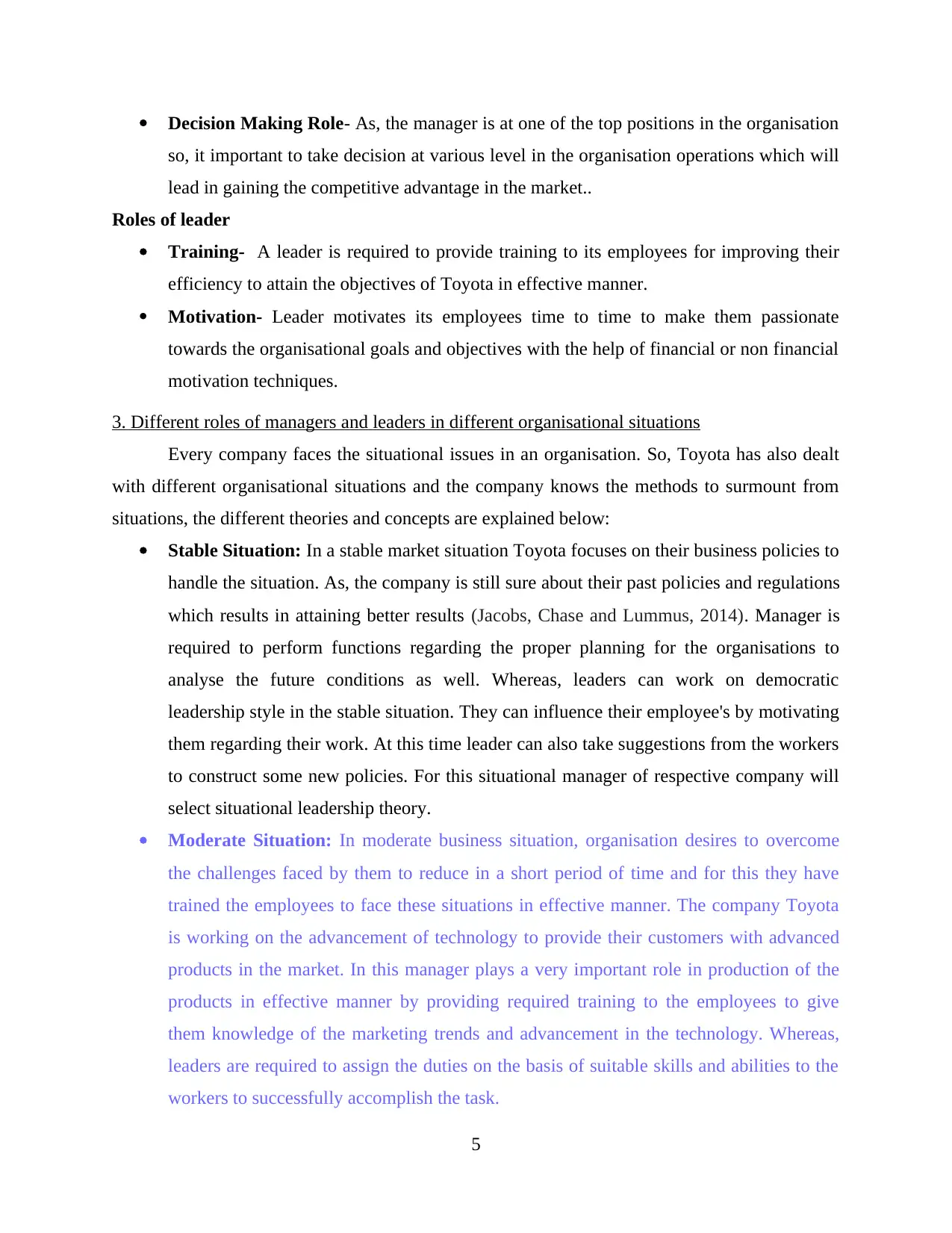
Decision Making Role- As, the manager is at one of the top positions in the organisation
so, it important to take decision at various level in the organisation operations which will
lead in gaining the competitive advantage in the market..
Roles of leader
Training- A leader is required to provide training to its employees for improving their
efficiency to attain the objectives of Toyota in effective manner.
Motivation- Leader motivates its employees time to time to make them passionate
towards the organisational goals and objectives with the help of financial or non financial
motivation techniques.
3. Different roles of managers and leaders in different organisational situations
Every company faces the situational issues in an organisation. So, Toyota has also dealt
with different organisational situations and the company knows the methods to surmount from
situations, the different theories and concepts are explained below:
Stable Situation: In a stable market situation Toyota focuses on their business policies to
handle the situation. As, the company is still sure about their past policies and regulations
which results in attaining better results (Jacobs, Chase and Lummus, 2014). Manager is
required to perform functions regarding the proper planning for the organisations to
analyse the future conditions as well. Whereas, leaders can work on democratic
leadership style in the stable situation. They can influence their employee's by motivating
them regarding their work. At this time leader can also take suggestions from the workers
to construct some new policies. For this situational manager of respective company will
select situational leadership theory.
Moderate Situation: In moderate business situation, organisation desires to overcome
the challenges faced by them to reduce in a short period of time and for this they have
trained the employees to face these situations in effective manner. The company Toyota
is working on the advancement of technology to provide their customers with advanced
products in the market. In this manager plays a very important role in production of the
products in effective manner by providing required training to the employees to give
them knowledge of the marketing trends and advancement in the technology. Whereas,
leaders are required to assign the duties on the basis of suitable skills and abilities to the
workers to successfully accomplish the task.
5
so, it important to take decision at various level in the organisation operations which will
lead in gaining the competitive advantage in the market..
Roles of leader
Training- A leader is required to provide training to its employees for improving their
efficiency to attain the objectives of Toyota in effective manner.
Motivation- Leader motivates its employees time to time to make them passionate
towards the organisational goals and objectives with the help of financial or non financial
motivation techniques.
3. Different roles of managers and leaders in different organisational situations
Every company faces the situational issues in an organisation. So, Toyota has also dealt
with different organisational situations and the company knows the methods to surmount from
situations, the different theories and concepts are explained below:
Stable Situation: In a stable market situation Toyota focuses on their business policies to
handle the situation. As, the company is still sure about their past policies and regulations
which results in attaining better results (Jacobs, Chase and Lummus, 2014). Manager is
required to perform functions regarding the proper planning for the organisations to
analyse the future conditions as well. Whereas, leaders can work on democratic
leadership style in the stable situation. They can influence their employee's by motivating
them regarding their work. At this time leader can also take suggestions from the workers
to construct some new policies. For this situational manager of respective company will
select situational leadership theory.
Moderate Situation: In moderate business situation, organisation desires to overcome
the challenges faced by them to reduce in a short period of time and for this they have
trained the employees to face these situations in effective manner. The company Toyota
is working on the advancement of technology to provide their customers with advanced
products in the market. In this manager plays a very important role in production of the
products in effective manner by providing required training to the employees to give
them knowledge of the marketing trends and advancement in the technology. Whereas,
leaders are required to assign the duties on the basis of suitable skills and abilities to the
workers to successfully accomplish the task.
5
Paraphrase This Document
Need a fresh take? Get an instant paraphrase of this document with our AI Paraphraser
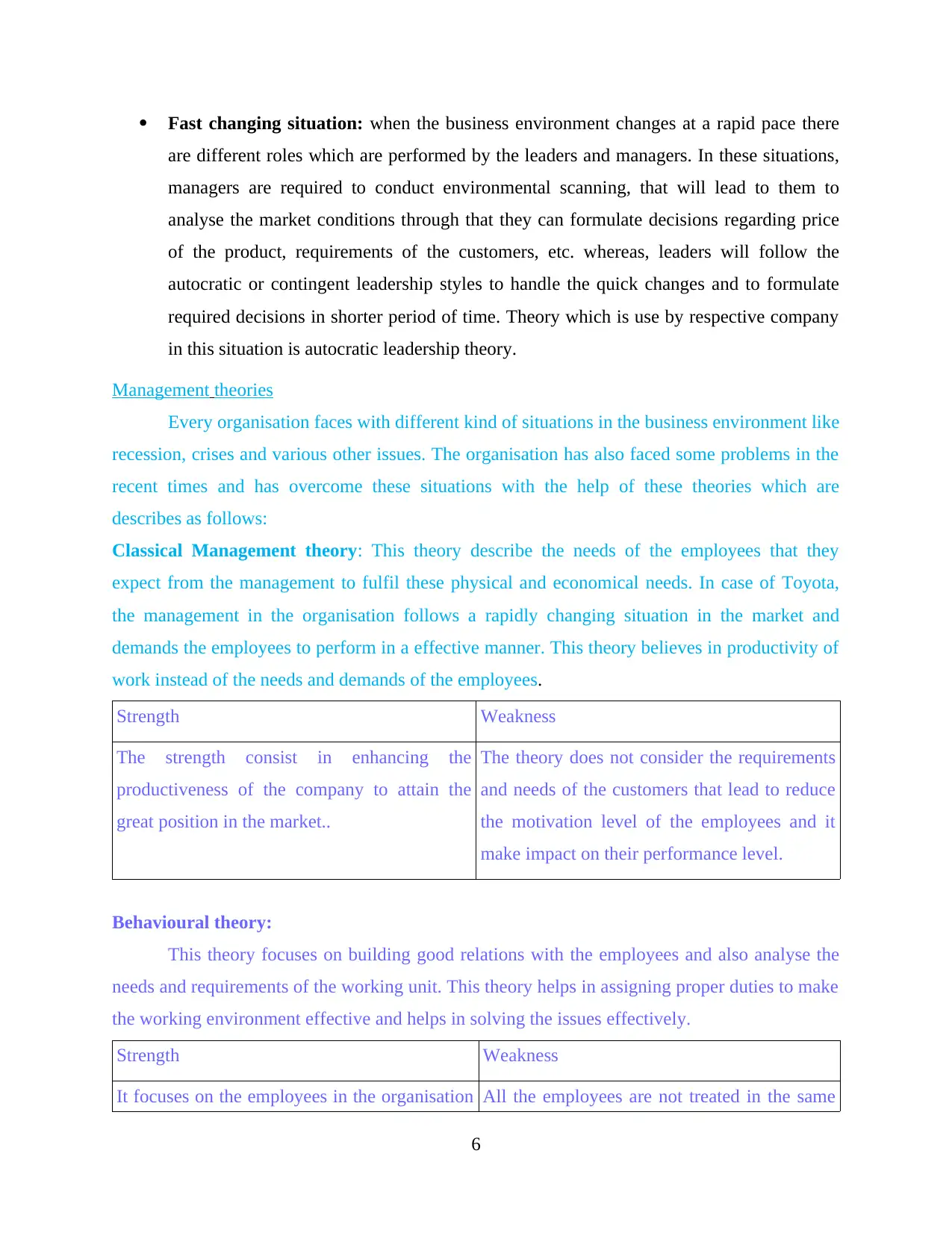
Fast changing situation: when the business environment changes at a rapid pace there
are different roles which are performed by the leaders and managers. In these situations,
managers are required to conduct environmental scanning, that will lead to them to
analyse the market conditions through that they can formulate decisions regarding price
of the product, requirements of the customers, etc. whereas, leaders will follow the
autocratic or contingent leadership styles to handle the quick changes and to formulate
required decisions in shorter period of time. Theory which is use by respective company
in this situation is autocratic leadership theory.
Management theories
Every organisation faces with different kind of situations in the business environment like
recession, crises and various other issues. The organisation has also faced some problems in the
recent times and has overcome these situations with the help of these theories which are
describes as follows:
Classical Management theory: This theory describe the needs of the employees that they
expect from the management to fulfil these physical and economical needs. In case of Toyota,
the management in the organisation follows a rapidly changing situation in the market and
demands the employees to perform in a effective manner. This theory believes in productivity of
work instead of the needs and demands of the employees.
Strength Weakness
The strength consist in enhancing the
productiveness of the company to attain the
great position in the market..
The theory does not consider the requirements
and needs of the customers that lead to reduce
the motivation level of the employees and it
make impact on their performance level.
Behavioural theory:
This theory focuses on building good relations with the employees and also analyse the
needs and requirements of the working unit. This theory helps in assigning proper duties to make
the working environment effective and helps in solving the issues effectively.
Strength Weakness
It focuses on the employees in the organisation All the employees are not treated in the same
6
are different roles which are performed by the leaders and managers. In these situations,
managers are required to conduct environmental scanning, that will lead to them to
analyse the market conditions through that they can formulate decisions regarding price
of the product, requirements of the customers, etc. whereas, leaders will follow the
autocratic or contingent leadership styles to handle the quick changes and to formulate
required decisions in shorter period of time. Theory which is use by respective company
in this situation is autocratic leadership theory.
Management theories
Every organisation faces with different kind of situations in the business environment like
recession, crises and various other issues. The organisation has also faced some problems in the
recent times and has overcome these situations with the help of these theories which are
describes as follows:
Classical Management theory: This theory describe the needs of the employees that they
expect from the management to fulfil these physical and economical needs. In case of Toyota,
the management in the organisation follows a rapidly changing situation in the market and
demands the employees to perform in a effective manner. This theory believes in productivity of
work instead of the needs and demands of the employees.
Strength Weakness
The strength consist in enhancing the
productiveness of the company to attain the
great position in the market..
The theory does not consider the requirements
and needs of the customers that lead to reduce
the motivation level of the employees and it
make impact on their performance level.
Behavioural theory:
This theory focuses on building good relations with the employees and also analyse the
needs and requirements of the working unit. This theory helps in assigning proper duties to make
the working environment effective and helps in solving the issues effectively.
Strength Weakness
It focuses on the employees in the organisation All the employees are not treated in the same
6
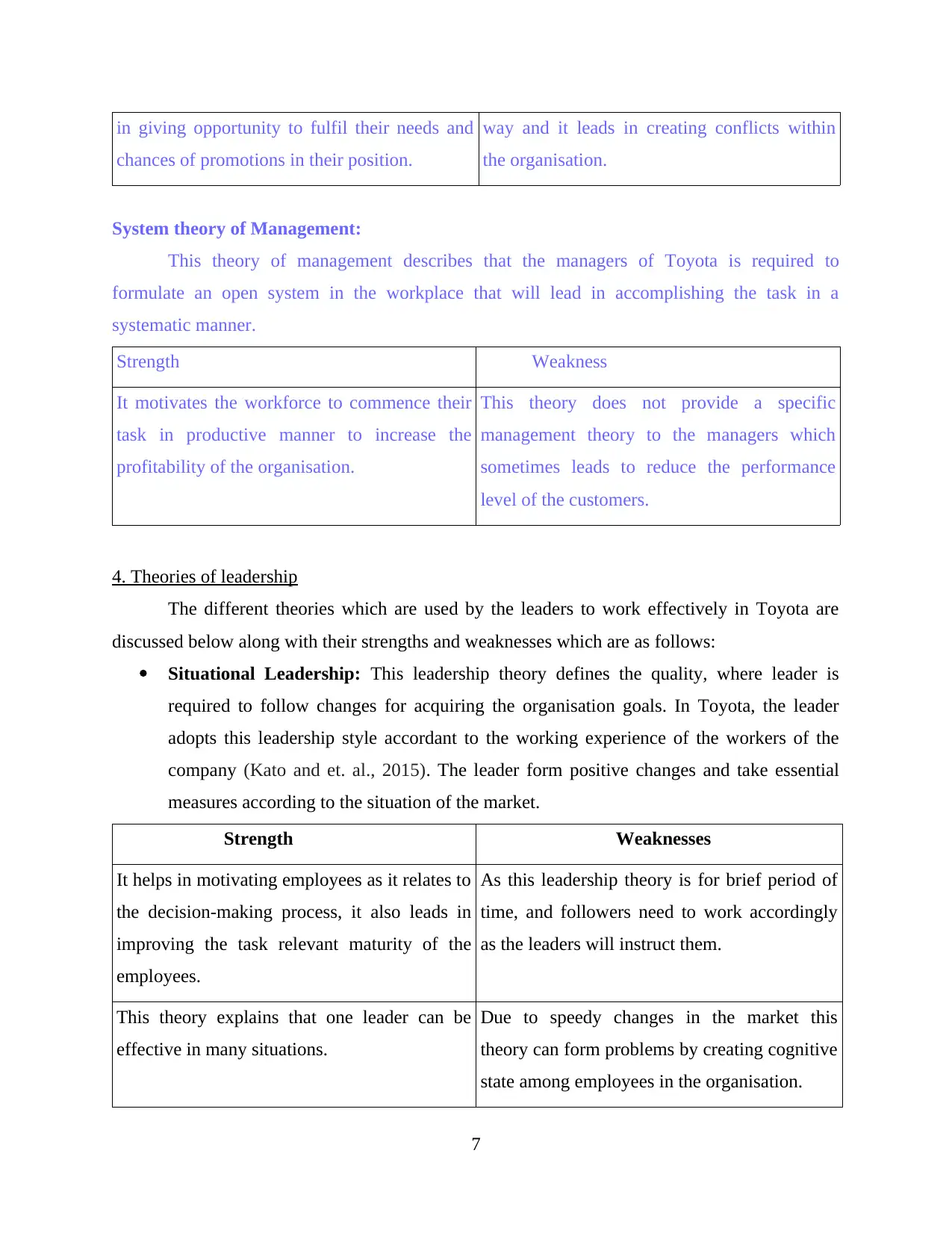
in giving opportunity to fulfil their needs and
chances of promotions in their position.
way and it leads in creating conflicts within
the organisation.
System theory of Management:
This theory of management describes that the managers of Toyota is required to
formulate an open system in the workplace that will lead in accomplishing the task in a
systematic manner.
Strength Weakness
It motivates the workforce to commence their
task in productive manner to increase the
profitability of the organisation.
This theory does not provide a specific
management theory to the managers which
sometimes leads to reduce the performance
level of the customers.
4. Theories of leadership
The different theories which are used by the leaders to work effectively in Toyota are
discussed below along with their strengths and weaknesses which are as follows:
Situational Leadership: This leadership theory defines the quality, where leader is
required to follow changes for acquiring the organisation goals. In Toyota, the leader
adopts this leadership style accordant to the working experience of the workers of the
company (Kato and et. al., 2015). The leader form positive changes and take essential
measures according to the situation of the market.
Strength Weaknesses
It helps in motivating employees as it relates to
the decision-making process, it also leads in
improving the task relevant maturity of the
employees.
As this leadership theory is for brief period of
time, and followers need to work accordingly
as the leaders will instruct them.
This theory explains that one leader can be
effective in many situations.
Due to speedy changes in the market this
theory can form problems by creating cognitive
state among employees in the organisation.
7
chances of promotions in their position.
way and it leads in creating conflicts within
the organisation.
System theory of Management:
This theory of management describes that the managers of Toyota is required to
formulate an open system in the workplace that will lead in accomplishing the task in a
systematic manner.
Strength Weakness
It motivates the workforce to commence their
task in productive manner to increase the
profitability of the organisation.
This theory does not provide a specific
management theory to the managers which
sometimes leads to reduce the performance
level of the customers.
4. Theories of leadership
The different theories which are used by the leaders to work effectively in Toyota are
discussed below along with their strengths and weaknesses which are as follows:
Situational Leadership: This leadership theory defines the quality, where leader is
required to follow changes for acquiring the organisation goals. In Toyota, the leader
adopts this leadership style accordant to the working experience of the workers of the
company (Kato and et. al., 2015). The leader form positive changes and take essential
measures according to the situation of the market.
Strength Weaknesses
It helps in motivating employees as it relates to
the decision-making process, it also leads in
improving the task relevant maturity of the
employees.
As this leadership theory is for brief period of
time, and followers need to work accordingly
as the leaders will instruct them.
This theory explains that one leader can be
effective in many situations.
Due to speedy changes in the market this
theory can form problems by creating cognitive
state among employees in the organisation.
7
⊘ This is a preview!⊘
Do you want full access?
Subscribe today to unlock all pages.

Trusted by 1+ million students worldwide
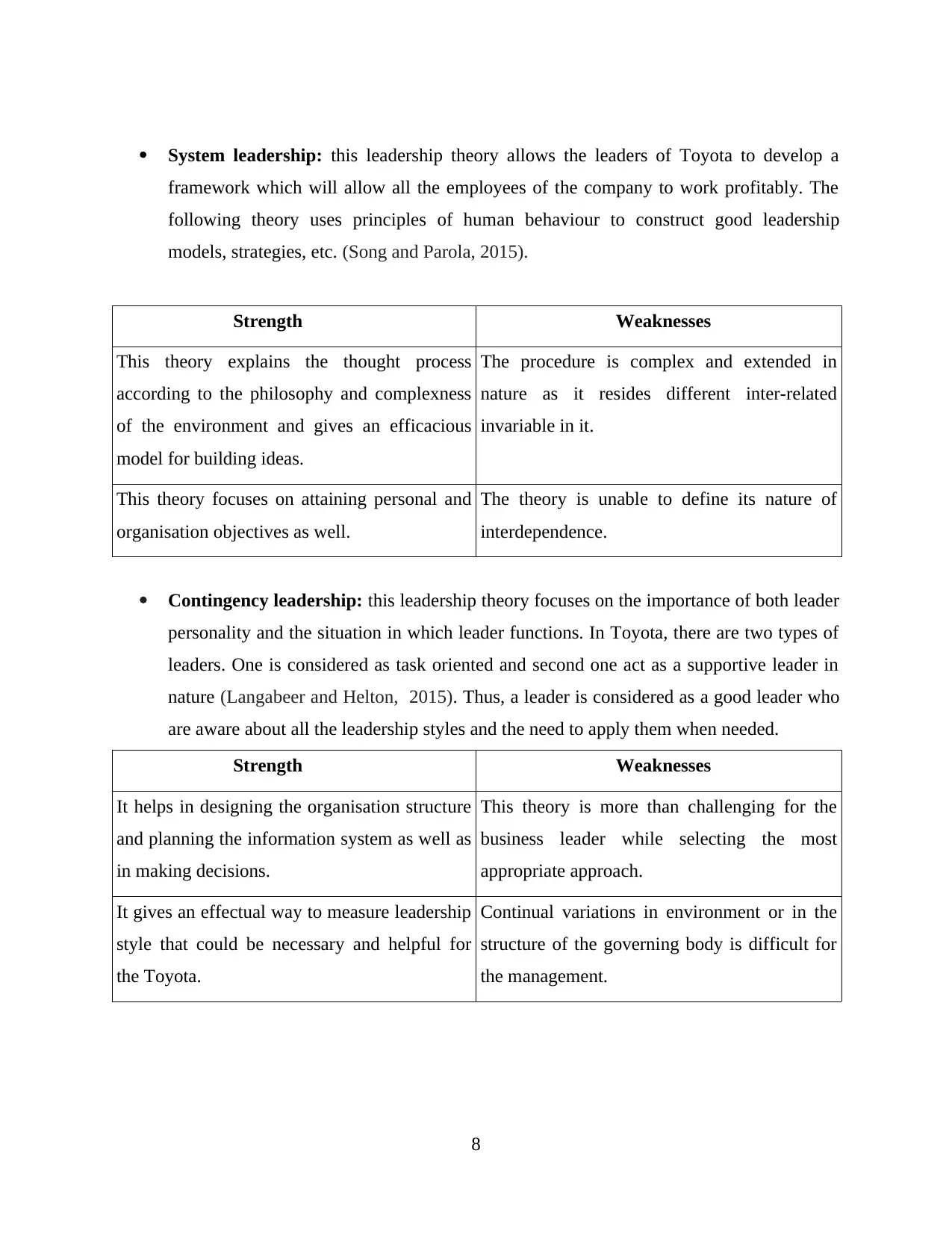
System leadership: this leadership theory allows the leaders of Toyota to develop a
framework which will allow all the employees of the company to work profitably. The
following theory uses principles of human behaviour to construct good leadership
models, strategies, etc. (Song and Parola, 2015).
Strength Weaknesses
This theory explains the thought process
according to the philosophy and complexness
of the environment and gives an efficacious
model for building ideas.
The procedure is complex and extended in
nature as it resides different inter-related
invariable in it.
This theory focuses on attaining personal and
organisation objectives as well.
The theory is unable to define its nature of
interdependence.
Contingency leadership: this leadership theory focuses on the importance of both leader
personality and the situation in which leader functions. In Toyota, there are two types of
leaders. One is considered as task oriented and second one act as a supportive leader in
nature (Langabeer and Helton, 2015). Thus, a leader is considered as a good leader who
are aware about all the leadership styles and the need to apply them when needed.
Strength Weaknesses
It helps in designing the organisation structure
and planning the information system as well as
in making decisions.
This theory is more than challenging for the
business leader while selecting the most
appropriate approach.
It gives an effectual way to measure leadership
style that could be necessary and helpful for
the Toyota.
Continual variations in environment or in the
structure of the governing body is difficult for
the management.
8
framework which will allow all the employees of the company to work profitably. The
following theory uses principles of human behaviour to construct good leadership
models, strategies, etc. (Song and Parola, 2015).
Strength Weaknesses
This theory explains the thought process
according to the philosophy and complexness
of the environment and gives an efficacious
model for building ideas.
The procedure is complex and extended in
nature as it resides different inter-related
invariable in it.
This theory focuses on attaining personal and
organisation objectives as well.
The theory is unable to define its nature of
interdependence.
Contingency leadership: this leadership theory focuses on the importance of both leader
personality and the situation in which leader functions. In Toyota, there are two types of
leaders. One is considered as task oriented and second one act as a supportive leader in
nature (Langabeer and Helton, 2015). Thus, a leader is considered as a good leader who
are aware about all the leadership styles and the need to apply them when needed.
Strength Weaknesses
It helps in designing the organisation structure
and planning the information system as well as
in making decisions.
This theory is more than challenging for the
business leader while selecting the most
appropriate approach.
It gives an effectual way to measure leadership
style that could be necessary and helpful for
the Toyota.
Continual variations in environment or in the
structure of the governing body is difficult for
the management.
8
Paraphrase This Document
Need a fresh take? Get an instant paraphrase of this document with our AI Paraphraser
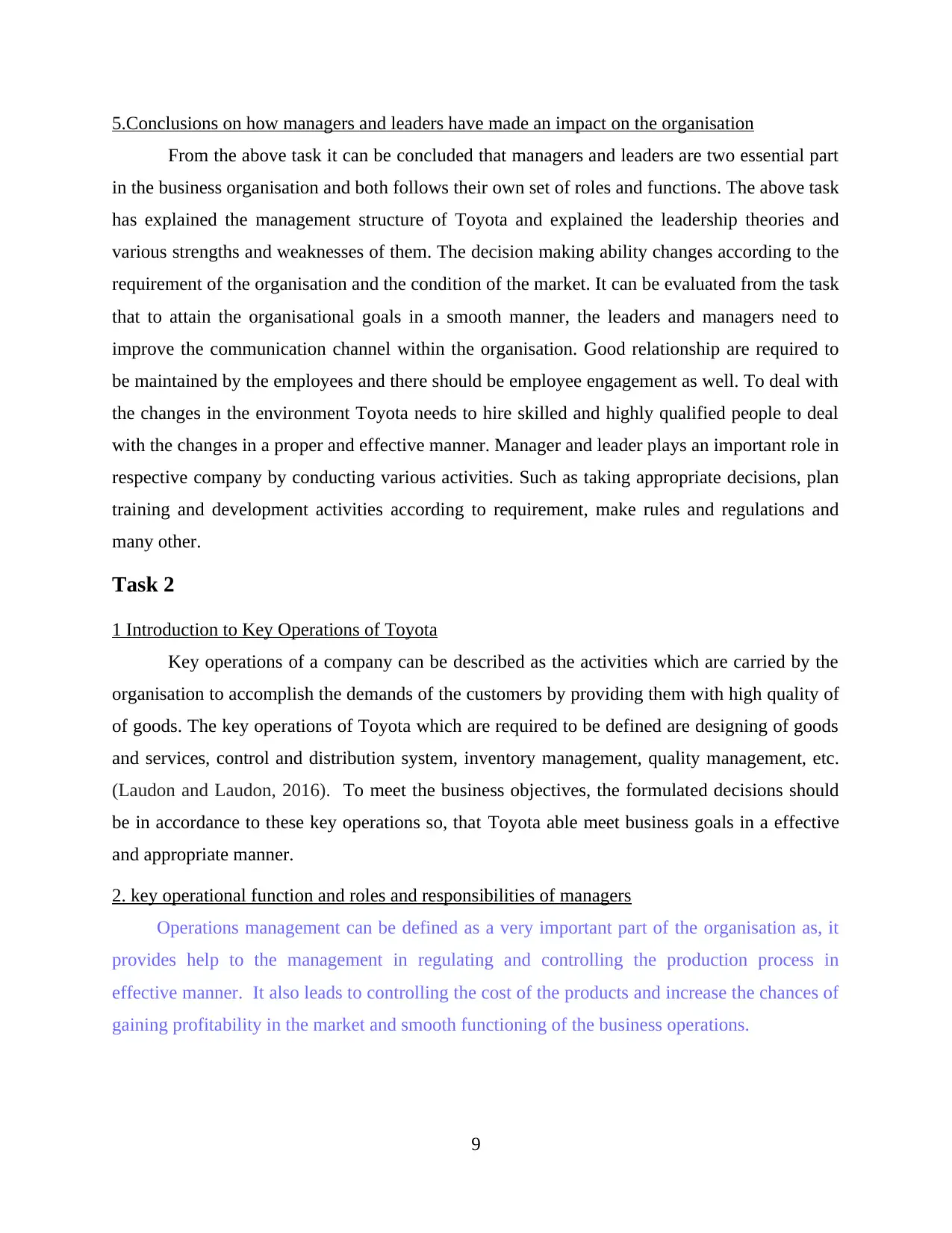
5.Conclusions on how managers and leaders have made an impact on the organisation
From the above task it can be concluded that managers and leaders are two essential part
in the business organisation and both follows their own set of roles and functions. The above task
has explained the management structure of Toyota and explained the leadership theories and
various strengths and weaknesses of them. The decision making ability changes according to the
requirement of the organisation and the condition of the market. It can be evaluated from the task
that to attain the organisational goals in a smooth manner, the leaders and managers need to
improve the communication channel within the organisation. Good relationship are required to
be maintained by the employees and there should be employee engagement as well. To deal with
the changes in the environment Toyota needs to hire skilled and highly qualified people to deal
with the changes in a proper and effective manner. Manager and leader plays an important role in
respective company by conducting various activities. Such as taking appropriate decisions, plan
training and development activities according to requirement, make rules and regulations and
many other.
Task 2
1 Introduction to Key Operations of Toyota
Key operations of a company can be described as the activities which are carried by the
organisation to accomplish the demands of the customers by providing them with high quality of
of goods. The key operations of Toyota which are required to be defined are designing of goods
and services, control and distribution system, inventory management, quality management, etc.
(Laudon and Laudon, 2016). To meet the business objectives, the formulated decisions should
be in accordance to these key operations so, that Toyota able meet business goals in a effective
and appropriate manner.
2. key operational function and roles and responsibilities of managers
Operations management can be defined as a very important part of the organisation as, it
provides help to the management in regulating and controlling the production process in
effective manner. It also leads to controlling the cost of the products and increase the chances of
gaining profitability in the market and smooth functioning of the business operations.
9
From the above task it can be concluded that managers and leaders are two essential part
in the business organisation and both follows their own set of roles and functions. The above task
has explained the management structure of Toyota and explained the leadership theories and
various strengths and weaknesses of them. The decision making ability changes according to the
requirement of the organisation and the condition of the market. It can be evaluated from the task
that to attain the organisational goals in a smooth manner, the leaders and managers need to
improve the communication channel within the organisation. Good relationship are required to
be maintained by the employees and there should be employee engagement as well. To deal with
the changes in the environment Toyota needs to hire skilled and highly qualified people to deal
with the changes in a proper and effective manner. Manager and leader plays an important role in
respective company by conducting various activities. Such as taking appropriate decisions, plan
training and development activities according to requirement, make rules and regulations and
many other.
Task 2
1 Introduction to Key Operations of Toyota
Key operations of a company can be described as the activities which are carried by the
organisation to accomplish the demands of the customers by providing them with high quality of
of goods. The key operations of Toyota which are required to be defined are designing of goods
and services, control and distribution system, inventory management, quality management, etc.
(Laudon and Laudon, 2016). To meet the business objectives, the formulated decisions should
be in accordance to these key operations so, that Toyota able meet business goals in a effective
and appropriate manner.
2. key operational function and roles and responsibilities of managers
Operations management can be defined as a very important part of the organisation as, it
provides help to the management in regulating and controlling the production process in
effective manner. It also leads to controlling the cost of the products and increase the chances of
gaining profitability in the market and smooth functioning of the business operations.
9

Every organisation requires various functions to manage the business activities. These
functions leads in dealing with these aspects in the organisation. The key operational functions of
Toyota and roles and responsibilities of managers are as follows:
Designing Goods and Services:
This procedure is related to designing the goods and services of Toyota. It also generates
new features for the present products of the organisation according to the needs of the customers.
R&D Department of the company is liable to carry this operation.
Roles and Responsibilities of Managers of Toyota are mentioned below:
Assuring that the technological resources are managed efficaciously by working with
different departments for designing the resource.
Insuring the use of available resources in fully efficient way.
Helping in the development of the design and guiding the team in taking effective
decisions so that improved results can be accomplished from their work.
Control and Distribution System:
This activity is very crucial factor in the operations of Toyota as this component is
accountable for controlling the production process and insuring proper organisation of products
in order to carry out the demand of the market (Slack and Brandon-Jones, 2018).
Roles and Responsibilities of managers are.
Assuring proper and equal distribution of raw materials in the company.
Insuring the delivery of right products are delivered at right place and at right time.
Quality management:
quality management is related to ensuring the productiveness in the quality of the
products the company is offering to the customers (McCrie, 2015). The production system of the
Toyota helps the company to increase the quality in the production system.
Roles and Responsibilities of managers are.
Manager is required to formulate required changes to improve the quality.
Examining the material used in the production process.
Inventory management:
this operation is required to manage the stocks of the organisation. It very important for
Toyota to eradicate the problem of deficit in the supply process. The company make proper
10
functions leads in dealing with these aspects in the organisation. The key operational functions of
Toyota and roles and responsibilities of managers are as follows:
Designing Goods and Services:
This procedure is related to designing the goods and services of Toyota. It also generates
new features for the present products of the organisation according to the needs of the customers.
R&D Department of the company is liable to carry this operation.
Roles and Responsibilities of Managers of Toyota are mentioned below:
Assuring that the technological resources are managed efficaciously by working with
different departments for designing the resource.
Insuring the use of available resources in fully efficient way.
Helping in the development of the design and guiding the team in taking effective
decisions so that improved results can be accomplished from their work.
Control and Distribution System:
This activity is very crucial factor in the operations of Toyota as this component is
accountable for controlling the production process and insuring proper organisation of products
in order to carry out the demand of the market (Slack and Brandon-Jones, 2018).
Roles and Responsibilities of managers are.
Assuring proper and equal distribution of raw materials in the company.
Insuring the delivery of right products are delivered at right place and at right time.
Quality management:
quality management is related to ensuring the productiveness in the quality of the
products the company is offering to the customers (McCrie, 2015). The production system of the
Toyota helps the company to increase the quality in the production system.
Roles and Responsibilities of managers are.
Manager is required to formulate required changes to improve the quality.
Examining the material used in the production process.
Inventory management:
this operation is required to manage the stocks of the organisation. It very important for
Toyota to eradicate the problem of deficit in the supply process. The company make proper
10
⊘ This is a preview!⊘
Do you want full access?
Subscribe today to unlock all pages.

Trusted by 1+ million students worldwide
1 out of 19
Related Documents
Your All-in-One AI-Powered Toolkit for Academic Success.
+13062052269
info@desklib.com
Available 24*7 on WhatsApp / Email
![[object Object]](/_next/static/media/star-bottom.7253800d.svg)
Unlock your academic potential
Copyright © 2020–2025 A2Z Services. All Rights Reserved. Developed and managed by ZUCOL.





